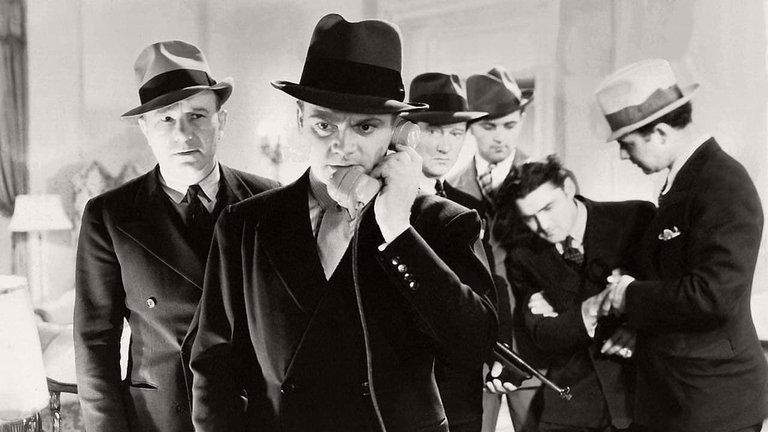Film Review: G Men (1935)

Hollywood was always willing to serve as propaganda tool for US government. Cooperation between those entities was sometimes mutually beneficial and on some rare occasions both entities were solving each other’s PR issues. One of the more examples can be found in G Men, 1935 crime film directed by William Keighley.
Protagonist is James “Brick” Davis (played by James Cagney), young lawyer in New York City who, despite growing in “gutter” and having his education provided kind-hearted gangster “Mac” McKay (played by William Harrigan), strives to do the right thing and stay clear of crime and criminals. He is visited by former law school classmate and friend Edward “Eddie” Buchanan (played by Regis Toomey) who works for Bureau of Investigation within Justice Department. He asks Davis to join him there, but Davis would apply only after Buchanan gets killed while investigating gang of criminals led by Danny Leggett (played by Edward Pawley). Davis, motivated by desire to avenge his friend, is initially at odds with his instructor and superior Jeffrey “Jeff” McCord (played by Robert Armstrong), but two men gradually learn to respect each other. McCord appreciates Davis’ physical skills and street smarts, while Davis becomes attracted to McCord’s sister Kay (played by Margaret Lindsay).
G Men was made during Great Depression, when large swaths of impoverished American masses viewed John Dillinger and other criminals robbing despised banks as folk heroes. Those who saw Dillinger and his ilk as “public enemies”, on the other hand, were prone to attack Hollywood gangster films for alleged glamorising of criminal lifestyle and thus contributing to crime spree. At the same time, Division of Investigation within Justice Department, institution that would in 1935 become FBI, has barely won its campaign against Dillinger and although its director J. Edgar Hoover has secured its status of national police force, his position still looked precarious. At the same time Warner Bros., studio that, thanks to classics like Little Caesar and The Public Enemy, had became associated with gangster genre, had to do something in order to erase general impression of inspiring future criminals. The way to do it was to make spectacular new crime action film in which, instead of gangsters, protagonist would be dedicated crime fighter of Hoover’s Bureau (or “G Man” as the press began to call them at the time) played by James Cagney, the very same actor who became star by playing charismatic larger-than-life criminal in The Public Enemy.
G Men is from strictly technical standpoint a solid film, a prime example of Hollywood craftsmanship in Classic era. Director William Keighley directs it confidently and maintains good tempo, making the film, despite many characters and subplots, play out in comprehensive and efficient way, ending in less than hour and half. Script provides good balance between drama and action, the latter represented in spectacular shoot outs. Two of those scenes were inspired by recent real life events during FBI campaign against Dillinger and his associates – 1933 Kansas City Massacre and 1934 raid on Little Bohemia (which, unlike the raid portrayed in film, actually ended as embarrassing fiasco for Hoover’s agents). Cagney, who finally plays morally unquestionable protagonist, brings just enough intensity to his role to make it believable. He has good chemistry with character actor Robert Armstong (best known for the role of Carl Denham in King Kong) and the relationship between two men naturally evolves from initial hostility to respect and friendship.
G Men is good but hardly classics. Most of its flaws come from commercial considerations. The relatively simple story is burdened by cliched romantic subplot involving character of Kay as “good girl” and even more burdened by character of Davis’ old friend, night club singer Jean Morgan Collins (played by Ann Dvorak), who is supposed to be “bad girl” and, despite doing the right thing at the end, suffers very cliched fate. Her “badness” is, like many details in the films, compromised with brutal enforcement of Hays Code which forced scriptwriter to have her character, who would have been a “woman of loose morals” only few years earlier, married to one of the gangsters. Hays Code also affected action in the film, because gangsters were suddenly forbidden from using their iconic weapon – Tommy Gun, which was now available only to the forces of law and order. Despite those limitations, G Men performed well at the box office and J. Edgar Hoover, who was becoming the most powerful man in the country, was delighted. In 1949, at the 25th anniversary of his takeover of FBI, a short prologue was added in the film featuring David Brian as senior agent describing Bureau’s early years and mentioning Davis as hero of the era.
RATING: 6/10 (++)
Blog in Croatian https://draxblog.com
Blog in English https://draxreview.wordpress.com/
Leofinance blog https://leofinance.io/@drax.leo
Unstoppable Domains: https://unstoppabledomains.com/?ref=3fc23fc42c1b417
Hiveonboard: https://hiveonboard.com?ref=drax
Bitcoin Lightning HIVE donations: https://v4v.app/v1/lnurlp/qrcode/drax
Rising Star game: https://www.risingstargame.com?referrer=drax
1Inch: https://1inch.exchange/#/r/0x83823d8CCB74F828148258BB4457642124b1328e
BTC donations: 1EWxiMiP6iiG9rger3NuUSd6HByaxQWafG
ETH donations: 0xB305F144323b99e6f8b1d66f5D7DE78B498C32A7

Nice review!!!
Congratulations @drax! You have completed the following achievement on the Hive blockchain And have been rewarded with New badge(s)
You can view your badges on your board and compare yourself to others in the Ranking
If you no longer want to receive notifications, reply to this comment with the word
STOPCheck out our last posts: